Leonide Martin's Blog: Lennie's Blog, page 7
February 19, 2014
Yohl Ik’nal – The Visionary Mayan Queen
Just published Kindle ebook
Records of Mayan civilization and history show that Yohl Ik’nal was one of a very small number of Mayan women who carried a full royal title and ruled in her own right. She acceded to the throne of Palenque (Lakam Ha) in 583 CE and reigned for a full term of twenty-one years. Archeologists believe that she was probably the daughter of the previous ruler Kan Bahlam I, who died without leaving a male heir. The Maya were initially thought to prefer patrilineal descent, but later research showed that their rulership system is complex with regional variations. For example, at Tonina rulership was not hereditary and rulers were elected from within elite nobles of the city. Mayan kings often had long lives and produced several children, whose descendants were of royal blood and frequently contended for rulership. There is clear evidence that women passed the right to rule to their husbands and sons at several sites, including Palenque, Tikal and Naranjo.
My novel The Visionary Queen: Yohl Ik’nal of Palenque is based on 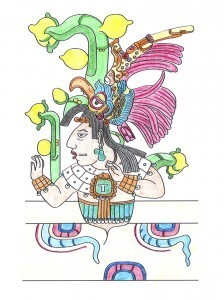 extensive research of Mayan history and culture. I was inspired to portray her as a visionary Mayan queen by Gerardo Aldana’s comment in his book The Apotheosis of Janaab’ Pakal: “Her rule must have been impressive, for it withstood attacks from two Usumacinta-region neighbors . . allowing her to remain in power for longer than her contemporaries in the region.” She certainly was a remarkable woman, the first Mayan queen ruling in her own right a full term, preserving the Bahlam dynasty of her father. This image of Yohl Ik’nal was carved on the sarcophagus lid of Janaab Pakal in the Temple of the Inscriptions, Palenque.
extensive research of Mayan history and culture. I was inspired to portray her as a visionary Mayan queen by Gerardo Aldana’s comment in his book The Apotheosis of Janaab’ Pakal: “Her rule must have been impressive, for it withstood attacks from two Usumacinta-region neighbors . . allowing her to remain in power for longer than her contemporaries in the region.” She certainly was a remarkable woman, the first Mayan queen ruling in her own right a full term, preserving the Bahlam dynasty of her father. This image of Yohl Ik’nal was carved on the sarcophagus lid of Janaab Pakal in the Temple of the Inscriptions, Palenque.
How might she have attained the throne, withstood two attacks, retained her power and continued the dynasty? In my story, she does this through her exceptional visionary abilities. She developed visionary powers in early childhood, including shamanic journeying and prophecies, and strengthened these throughout her life. Mayan rituals are well documented, and we know from numerous inscriptions that rulers went into altered states of consciousness to invoke the “Vision Serpent.” They used self-inflicted blood letting and hallucinatory substances to enter trance states, in which they envisioned deities and ancestors emerging from the Vision Serpent’s mouth. The picture below depicts a Mayan queen, Lady Xoc of Yaxchilan, having a vision of an ancestor emerging from the 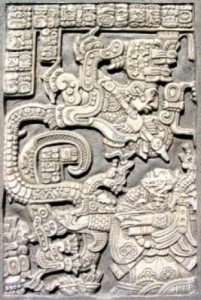 serpent’s mouth to bring her a prophetic message.
serpent’s mouth to bring her a prophetic message.
Few Mayan books propel readers into the living world of the ancient Mayans. This historically based novel brings Yohl Ik’nal and her people authentically to life in extravagant court ceremonies, exotic rituals in Mayan temples, political maneuvering, battles and revenge, and intimate personal relationships. Enter this world and discover how the Visionary Mayan Queen fulfilled her destiny.


February 15, 2014
Yohl Ik’nal – The Visionary Mayan Queen
Just published Kindle ebook
Records of Mayan civilization and history show that Yohl Ik’nal was one of a very small number of Mayan women who carried a full royal title and ruled in her own right. She acceded to the throne of Palenque (Lakam Ha) in 583 CE and reigned for a full term of twenty-one years. Archeologists believe that she was probably the daughter of the previous ruler Kan Bahlam I, who died without leaving a male heir. The Maya were initially thought to prefer patrilineal descent, but later research showed that their rulership system is complex with regional variations. For example, at Tonina rulership was not hereditary and rulers were elected from within elite nobles of the city. Mayan kings often had long lives and produced several children, whose descendants were of royal blood and frequently contended for rulership. There is clear evidence that women passed the right to rule to their husbands and sons at several sites, including Palenque, Tikal and Naranjo.
My novel The Visionary Queen: Yohl Ik’nal of Palenque is based on  extensive research of Mayan history and culture. I was inspired to portray her as a visionary Mayan queen by Gerardo Aldana’s comment in his book The Apotheosis of Janaab’ Pakal: “Her rule must have been impressive, for it withstood attacks from two Usumacinta-region neighbors . . allowing her to remain in power for longer than her contemporaries in the region.” She certainly was a remarkable woman, the first Mayan queen ruling in her own right a full term, preserving the Bahlam dynasty of her father. This image of Yohl Ik’nal was carved on the sarcophagus lid of Janaab Pakal in the Temple of the Inscriptions, Palenque.
extensive research of Mayan history and culture. I was inspired to portray her as a visionary Mayan queen by Gerardo Aldana’s comment in his book The Apotheosis of Janaab’ Pakal: “Her rule must have been impressive, for it withstood attacks from two Usumacinta-region neighbors . . allowing her to remain in power for longer than her contemporaries in the region.” She certainly was a remarkable woman, the first Mayan queen ruling in her own right a full term, preserving the Bahlam dynasty of her father. This image of Yohl Ik’nal was carved on the sarcophagus lid of Janaab Pakal in the Temple of the Inscriptions, Palenque.
How might she have attained the throne, withstood two attacks, retained her power and continued the dynasty? In my story, she does this through her exceptional visionary abilities. She developed visionary powers in early childhood, including shamanic journeying and prophecies, and strengthened these throughout her life. Mayan rituals are well documented, and we know from numerous inscriptions that rulers went into altered states of consciousness to invoke the “Vision Serpent.” They used self-inflicted blood letting and hallucinatory substances to enter trance states, in which they envisioned deities and ancestors emerging from the Vision Serpent’s mouth. The picture below depicts a Mayan queen, Lady Xoc of Yaxchilan, having a vision of an ancestor emerging from the  serpent’s mouth to bring her a prophetic message.
serpent’s mouth to bring her a prophetic message.
Few Mayan books propel readers into the living world of the ancient Mayans. This historically based novel brings Yohl Ik’nal and her people authentically to life in extravagant court ceremonies, exotic rituals in Mayan temples, political maneuvering, battles and revenge, and intimate personal relationships. Enter this world and discover how the Visionary Mayan Queen fulfilled her destiny.


February 5, 2014
Yohl Ik’nal – The Visionary Mayan Queen
Just published Kindle ebook
Records of Mayan civilization and history show that Yohl Ik’nal was one of a very small number of Mayan women who carried a full royal title and ruled in her own right. She acceded to the throne of Palenque (Lakam Ha) in 583 CE and reigned for a full term of twenty-one years. Archeologists believe that she was probably the daughter of the previous ruler Kan Bahlam I, who died without leaving a male heir. The Maya were initially thought to prefer patrilineal descent, but later research showed that their rulership system is complex with regional variations. For example, at Tonina rulership was not hereditary and rulers were elected from within elite nobles of the city. Mayan kings often had long lives and produced several children, whose descendants were of royal blood and frequently contended for rulership. There is clear evidence that women passed the right to rule to their husbands and sons at several sites, including Palenque, Tikal and Naranjo.
My novel The Visionary Queen: Yohl Ik’nal of Palenque is based on  extensive research of Mayan history and culture. I was inspired to portray her as a visionary Mayan queen by Gerardo Aldana’s comment in his book The Apotheosis of Janaab’ Pakal: “Her rule must have been impressive, for it withstood attacks from two Usumacinta-region neighbors . . allowing her to remain in power for longer than her contemporaries in the region.” She certainly was a remarkable woman, the first Mayan queen ruling in her own right a full term, preserving the Bahlam dynasty of her father. This image of Yohl Ik’nal was carved on the sarcophagus lid of Janaab Pakal in the Temple of the Inscriptions, Palenque.
extensive research of Mayan history and culture. I was inspired to portray her as a visionary Mayan queen by Gerardo Aldana’s comment in his book The Apotheosis of Janaab’ Pakal: “Her rule must have been impressive, for it withstood attacks from two Usumacinta-region neighbors . . allowing her to remain in power for longer than her contemporaries in the region.” She certainly was a remarkable woman, the first Mayan queen ruling in her own right a full term, preserving the Bahlam dynasty of her father. This image of Yohl Ik’nal was carved on the sarcophagus lid of Janaab Pakal in the Temple of the Inscriptions, Palenque.
How might she have attained the throne, withstood two attacks, retained her power and continued the dynasty? In my story, she does this through her exceptional visionary abilities. She developed visionary powers in early childhood, including shamanic journeying and prophecies, and strengthened these throughout her life. Mayan rituals are well documented, and we know from numerous inscriptions that rulers went into altered states of consciousness to invoke the “Vision Serpent.” They used self-inflicted blood letting and hallucinatory substances to enter trance states, in which they envisioned deities and ancestors emerging from the Vision Serpent’s mouth. The picture below depicts a Mayan queen, Lady Xoc of Yaxchilan, having a vision of an ancestor emerging from the  serpent’s mouth to bring her a prophetic message.
serpent’s mouth to bring her a prophetic message.
Few Mayan books propel readers into the living world of the ancient Mayans. This historically based novel brings Yohl Ik’nal and her people authentically to life in extravagant court ceremonies, exotic rituals in Mayan temples, political maneuvering, battles and revenge, and intimate personal relationships. Enter this world and discover how the Visionary Mayan Queen fulfilled her destiny.


December 24, 2013
Look for new blog posts about the releas
Look for new blog posts about the release of “The Visionary Mayan Queen: Yohl Ik’nal of Palenque.” Coming in January 2014! http://ow.ly/i/47J4c


October 31, 2013
Mists of Palenque
In dense tropical forests of southern Mexico, the “Mists of Palenque” drape 1300-foot mountain peaks behind the ancient Mayan city called Lakam Ha – Place of Big Water.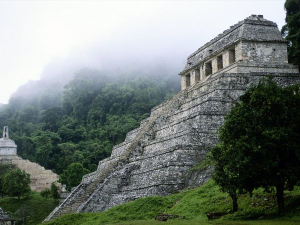 Ruins of pyramids, temples, palaces and wide plazas cluster on a narrow plateau about a quarter of the way up the steep mountains; the northern edge of the Chiapas highlands. Tall trees with draping lianas form a rain forest canopy, bathed by 120 inches of rain annually. Nine streams drain across the plateau and empty into rivers that snake across the plains below, flowing northwest to the Gulf of Mexico.
Ruins of pyramids, temples, palaces and wide plazas cluster on a narrow plateau about a quarter of the way up the steep mountains; the northern edge of the Chiapas highlands. Tall trees with draping lianas form a rain forest canopy, bathed by 120 inches of rain annually. Nine streams drain across the plateau and empty into rivers that snake across the plains below, flowing northwest to the Gulf of Mexico.
Palenque is the most mystical and magical of Mayan sites. Its architecture is unique with delicate filigreed roofcombs on temples perched on hilltops, decorated with exquisite bas relief panels of splendidly attired rulers and deities, carved with glyphs in an elegant incursive style. Looking north across the wide plains far below, the city is surrounded by lush tropical forests rich in edible fruits, plants, flowers and wildlife. The mountains rise dramatically to the south, their peaks often draped in mist.
The “Mists of Palenque” – their swirling fingers furrow through mountain crevices, hover like silvery drapes over hillsides, seep across plazas to lap at the base of stone stairways. The mists hide more than palaces and pyramids and temples. For centuries they obscured from view the lives of those ancient Maya people who once lived in this magnificent city. Now their story is told in my new novel: Mists of Palenque, Four Great Mayan Queens of Lakam Ha. Coming as an ebook 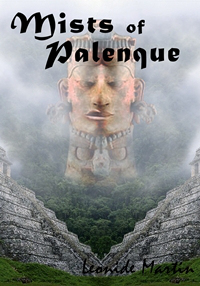 series in December, 2013.
series in December, 2013.
The Spaniards gave this ancient Mayan city the name Palenque, after the colonial town nearby. By 500 BCE early Mayans had settled the western area. Plentiful water and rich soil, natural protection and rivers for travel made it a desirable area. The abundant forests provided food, feathers and skins, and wood for building. The fresh mountain streams were channeled through buildings for bathing and toileting, burst into fountains in plazas, pooled in deep wells for drinking, and cascaded over boulders and down ravines bringing lyrical beauty to the environment.
By 400 CE, Lakam Ha (Palenque) had grown into a complex city that interacted with numerous others located along the mighty Usumacinta River, in the Chiapas highlands and the Peten lowlands (northern Guatemala). The Bahlam dynasty that ruled the city for 12 generations over 500 years, was founded by K’uk Bahlam I who acceded to rulership in 431 CE. Their lineage goes back over 2000 years to mythological time and divine beings in the sky. Rulers were the earthly embodiment of these ancestor gods, and kept harmony between humans and deities.


June 18, 2013
Wordpress Blog
June 16, 2013
Welcome to my Maya-inspired blog
June 15, 2013
Temple of the Sun, Palenque (Chiapas, Mexico)
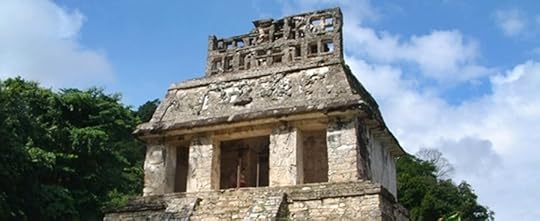
Palenque is captivating and mysterious. Temple of the Sun shows its exquisite architecture. Built by K’inich Kan Bahlam II in the late 600′s CE.


May 22, 2013
Serial ebook?
February 6, 2013
Lakam Ha (Palenque) Ancient Maya City
Life in Lakam Ha is the topic of my current book in progress. The story spans the lives of four great Maya "queens," two were rulers themselves and two married rulers, all in the lineage of K'inich Janaab Pakal, the most famous Maya ruler.
Drawing from archeology, anthropology and epigraphy, this HF aspires to depict their lives, conflicts, dreams, defeats and triumphs in a culture of immense creativity and profound knowledge.
Lennie's Blog
- Leonide Martin's profile
- 142 followers







